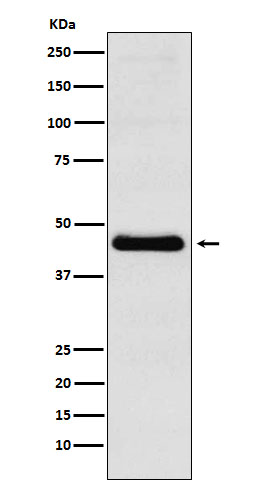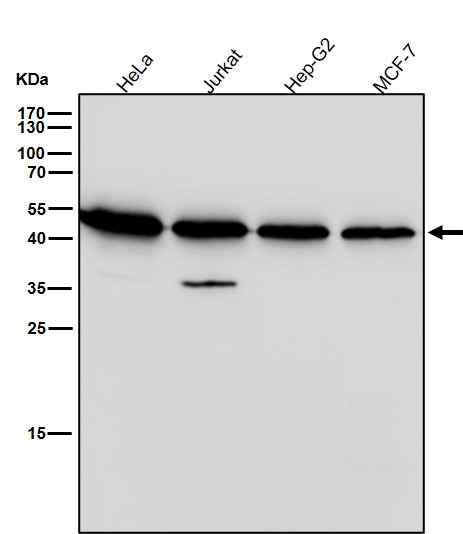


| WB | 1/1000-1/2000 | Human,Mouse,Rat |
| IF | 咨询技术 | Human,Mouse,Rat |
| IHC | 咨询技术 | Human,Mouse,Rat |
| ICC | 1/50-1/200 | Human,Mouse,Rat |
| FCM | 1/20-1/100 | Human,Mouse,Rat |
| Elisa | 咨询技术 | Human,Mouse,Rat |
| Aliases | BLR1; CD185; Cxcr5; MDR15;;CXCR5 |
| WB Predicted band size | 42 kDa |
| Host/Isotype | Rabbit IgG |
| Antibody Type | Primary antibody |
| Storage | Store at 4°C short term. Aliquot and store at -20°C long term. Avoid freeze/thaw cycles. |
| Species Reactivity | Human,Mouse,Rat |
| Immunogen | A synthesized peptide derived from human CXCR5 |
| Formulation | Purified antibody in PBS with 0.05% sodium azide,0.05% BSA and 50% glycerol. |
+ +
以下是3篇关于CXCR5抗体的代表性文献,按研究领域分类简要概括:
---
1. **文献名称**:*CXCR5 governs lymphoid tissue seeding and immunoglobulin class switch via antigen upregulation*
**作者**:Ansel KM, et al.
**摘要**:研究利用抗CXCR5抗体阻断B细胞趋化因子CXCL13信号,发现CXCR5对B细胞归巢至淋巴滤泡及抗体类别转换的关键作用,为免疫调节提供机制依据。
2. **文献名称**:*Antibody-based detection of Th17-associated CXCR5+ CD4 T cells in HIV infection*
**作者**:Mosmann T, et al.
**摘要**:开发针对CXCR5的流式抗体,用于检测HIV感染者中滤泡辅助性T细胞(Tfh)亚群,揭示其与病毒储存库的关联性,为免疫监测提供工具。
3. **文献名称**:*CXCR5+ T follicular helper cells in autoimmune disease: Targets for antibody-mediated depletion*
**作者**:Schaerli P, et al.
**摘要**:通过抗CXCR5抗体标记,鉴定自身免疫病中异常活化的滤泡辅助T细胞,提出靶向CXCR5的抗体疗法可能抑制病理性T-B细胞互作。
---
**领域扩展**:CXCR5抗体在肿瘤微环境研究中的应用(如Kim SJ, 2013. *CXCR5 signaling in breast cancer metastasis*)也值得关注,但需结合具体研究筛选。如需全文链接或更多方向文献,可进一步说明需求。
CXCR5. also known as CD185. is a G protein-coupled chemokine receptor that specifically binds to CXCL13. a chemokine critical for immune cell trafficking and lymphoid tissue organization. Primarily expressed on B cells, follicular helper T (Tfh) cells, and certain dendritic cells, CXCR5 guides these cells to germinal centers in lymphoid organs, facilitating adaptive immune responses like antibody production and B cell maturation. Dysregulation of the CXCR5/CXCL13 axis is linked to autoimmune diseases (e.g., rheumatoid arthritis, multiple sclerosis), lymphoma, and HIV pathogenesis.
CXCR5 antibodies are essential tools for studying immune cell migration, differentiation, and function. They enable the identification and isolation of CXCR5-expressing cells via flow cytometry or immunofluorescence, aiding research on germinal center dynamics and Tfh-B cell interactions. In therapeutic contexts, CXCR5-blocking antibodies are explored to modulate aberrant immune activity in autoimmunity or inhibit cancer metastasis. Conversely, agonistic antibodies might enhance vaccine efficacy by promoting germinal center formation. Recent studies also investigate CXCR5+ CAR-T cells for targeting B cell malignancies. Despite their potential, challenges remain in balancing specificity and off-target effects, necessitating further structural and functional characterization of CXCR5 epitopes. Overall, CXCR5 antibodies bridge basic immunology and translational research, offering insights into disease mechanisms and therapeutic strategies.
×